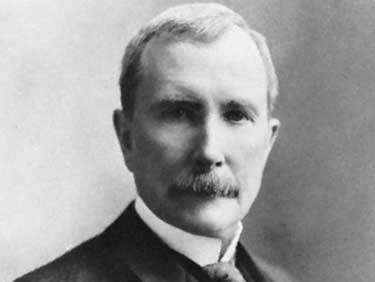When you look at the wealthiest men alive today, topping the charts are tech billionaires like Jeff Bezos and Bill Gates.
But actually, the wealthiest businessman to have ever lived died almost a century ago.
In this article, we’ll be looking at a business empire so vast that even after a hundred years of technological progress, no man has managed to overtake its founder.
This is the history of Standard Oil.
The origins of history’s greatest oil monopoly are actually pretty humble. It all starts in 1839 with the birth of John Rockefeller in upstate New York.

He was the eldest son of a traveling merchant, who identified himself as a “botanic physician“, but in reality was selling the 19th century equivalent of homeopathic medicine.
He would spend weeks away from home and in fact, would have several children with another woman, who he decided to bring back home to his wife so they could all live together.
In this very confusing household, John would grow up learning how to hustle people for the best deal possible and how to get the most out of every penny he got.
His family would rarely stay in one place for long, and John would live this nomadic lifestyle ever since he was three years old.
To help his mother, John would earn any money he could by raising turkeys or doing work for neighbors.
His intelligence was put to good use when the family moved to Cleveland, Ohio in 1854, where he got the chance to attend a proper school.
But less than a year later, John dropped out in order to work as a bookkeeper at a local produce broker.
He would earn $0.50 per day, which obviously wasn’t much at the time so he would help other companies on the side.
But after two years of working there, his bosses refused to give him a meaningful raise, so he decided to one-up them by starting his own produce brokerage.
Thanks to his good reputation he got a loan of $4,000 which at the time was a huge sum.
John started trading hay, grain, and various meats, and in his first year, he recorded sales of half a million dollars, of which he only got a small fraction as commissions, but still it was a huge success.
Every bank in Cleveland was begging John to borrow money and he was barely 18 years old.
But then, in 1859 something happened that would change his life forever.
Just a hundred miles east of Cleveland, the first American oil well had been discovered.

This marked the beginning of the Pennsylvania oil rush and within a year 4,500 barrels of oil would be produced.
Now, back then oil wasn’t quite as valuable as it is today gasoline cars hadn’t been invented yet, but oil could still be processed into kerosene, which people would then use in lamps.
John realized, however, that the biggest profits to be had weren’t in drilling for oil but in refining it.
He witnessed many people going bust before striking oil, so he knew that that business was too risky for him.
Instead, he’d let others go through the hassle of finding the oil and he would just buy it off of them.
John had to wait until 1863 for the government to build a rail line connecting the Pennsylvania oil fields to Cleveland.
But when that line was built, John was ready for it with a long line of partners and banks ready to back him up.
He also assembled a team of seasoned chemists and engineers, who not only optimized the refining process but also discovered various uses for the byproducts of refining petroleum.
You see, the early refineries in Cleveland could only operate at about 60% efficiency, but John increased that percentage, he also started selling all the byproducts, like paraffin wax, tar, and naphtha.
Within two years the Rockefeller refinery was worth over seventy thousand dollars and was among the largest in Cleveland.
But John wasn’t done: in 1865 there were 26 competing refineries but within 5 years John had acquired all but 4 of them.
By this point, his business was getting too big to handle as a partnership, so in 1870 he incorporated Standard Oil of Ohio.
To convince the few remaining competitors in Cleveland, John would simply invite them over and show them his books, revealing that he could operate at a loss for longer than they could stay solvent.
In exchange for a good buyout price, John would offer his competitors positions in his own company, thus placing the brightest minds in the industry under his control.
Of course, not everyone would give up immediately, and over time John eroded the price of oil and kerosene, sometimes by as much as 80%, in order to strangle competitors.
Unsurprisingly, his strategy worked by 1880 he had acquired refineries across the Northeastern US and was refining over 90% of the entire country’s oil production.
At this point, John was so powerful that he would invite the owners of the big rail companies and personally negotiate rebates for using their trains.
But this practice of negotiating backroom deals really got the business world riled up.
At the time (and still kind of today) most industrial goods were transported by rail, and many big industrialists got worried that John’s abuse of transportation rebates could result in similar monopolization in their industries.
Over the next decade businessmen, politicians and the media would attack Standard Oil with increasing ferocity.
Legislators in Ohio began drafting antitrust regulations to bring down Rockefeller, but he was one step ahead.
In 1882 he reincorporated in New Jersey, this time creating the Standard Oil Trust, which in turn held stakes in over 40 local companies.
Then, to showcase his success John built an impressive headquarters for his company on Broadway.
This moment was the highpoint of Rockefeller’s Standard Oil he owned 20,000 oil wells, 4,000 miles of pipeline, and employed over 100,000 people.
But, his grip on the oil industry was loosening, both domestically and abroad.
Massive oil deposits had been discovered in Russia and in Asia and were being developed by the Rothschild family, which spared no effort in getting that oil to America.
Worse yet, in 1890 the federal government passed the Sherman Antitrust Act, which finally gave politicians the teeth to go after the Standard Oil Trust itself.
Of course, the complex legal structure behind all the companies was very difficult to investigate, which is why the government couldn’t actually break up Standard Oil until 1911.
By that point, however, John Rockefeller had already cashed in and was no longer actively managing the company.
In the final 20 years of his company’s existence, it had paid out over half a billion dollars in dividends.
By some estimates, the true worth of Standard Oil at its peak was $1 trillion, so the breakup didn’t really come as a surprise to most people.
In 1911 the Supreme Court found Standard Oil guilty of anticompetitive practices and broke the company up into 34 separate entities.
Of course, John Rockefeller kept his stake in those companies until his death and in fact, it turns out that the breakup was the most profitable event in his life.
You see, over time many of those companies merged back with one another.
Today, most of the Standard remnants are part of either ExxonMobil, Chevron, or BP, which have since become incredibly large companies in their own right.
John Rockefeller’s ownership of these successor companies made him the richest businessman to have ever lived, with an estimated net worth of $400 billion.
Even today, no one has beaten Rockefeller in the leaderboard not even Jeff Bezos himself seems likely to achieve that.
Thanks for reading I hope this below video will help you to save time.




